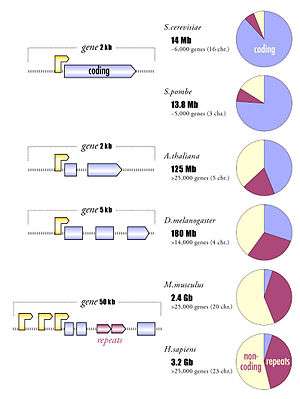Genomic organization

The hereditary material i.e. DNA(deoxyribonuclic acid) of an organism is composed of a sequence of four nucleotides in a specific pattern, which encode information as a function of their order. Genomic organization refers to the linear order of DNA elements and their division into chromosomes. "Genome organization" can also refer to the 3D structure of chromosomes and the positioning of DNA sequences within the nucleus.
Description
Organisms have a vast array of ways in which their respective genomes are organized. A comparison of the genomic organization of six major model organisms shows size expansion with the increase of complexity of the organism. There is a more than 300-fold difference between the genome sizes of yeast and mammals, but only a modest 4- to 5-fold increase in overall gene number (see the figure on the right). However, the ratio of coding to noncoding and repetitive sequences is indicative of the complexity of the genome: The largely "open" genomes of unicellular fungi have relatively little noncoding DNA compared with the highly heterochromatic genomes of multicellular organisms.
In particular, mammals have accumulated considerable repetitive elements and noncoding regions, which account for the majority of their DNA sequences (52% non-coding and 44% repetitive DNA).[1][2] Only 1.2% of the mammalian genome thus encodes for protein function. This massive expansion of repetitive and noncoding sequences in multicellular organisms is most likely due to the incorporation of invasive elements, such as DNA transposons, retrotransposons, and other repetitive elements.[3] The expansion of repetitive elements (such as Alu sequences) has even infiltrated the transcriptional units of the mammalian genome. This results in transcription units that are frequently much larger (30-200 kb), commonly containing multiple promoters and DNA repeats within untranslated introns.
The vast expansion of the genome with noncoding and repetitive DNA in higher eukaryotes implies more extensive epigenetic silencing mechanisms. Studies of the genomic organization is thought to be the future of genomic medicine, which will provide the opportunity for personalized prognoses in clinics.[4]
See also
References
- ↑ Venter G, et al., The Sequence of the Human Genome Science (2001) 291. pp1304-51
- ↑ R. A. Harris et al., Human-Specific Changes of Genome Structure Detected by Genomic Triangulation Science (2007) 316.5822, pp. 235-7
- ↑ Haig H. Kazazian, Jr. Mobile Elements: Drivers of Genome Evolution Science, Mar 2004; 303: 1626-32
- ↑ West M., et al., Embracing the complexity of genomic data for personalized medicine Genome Res. (2006)16:559-66